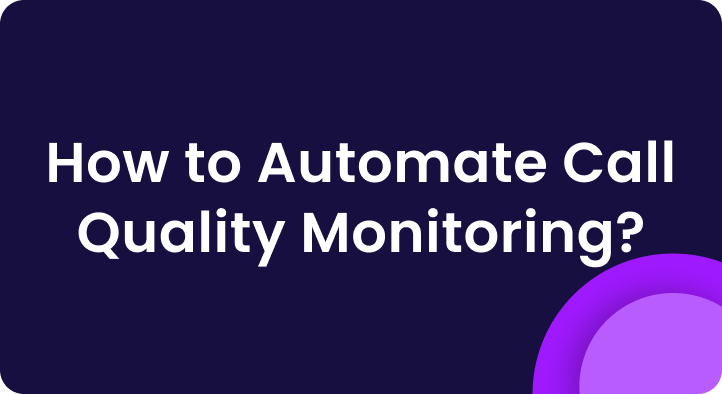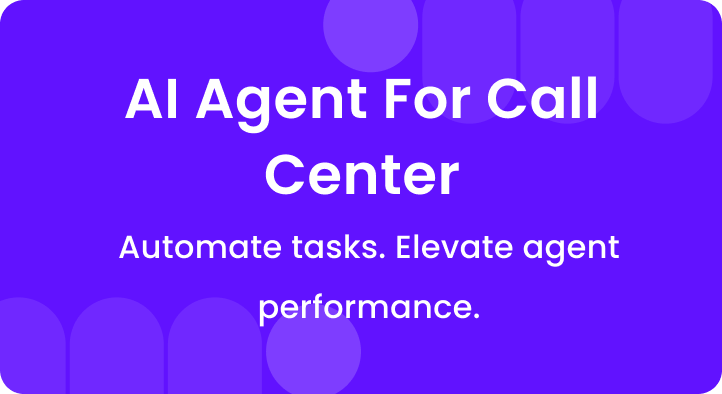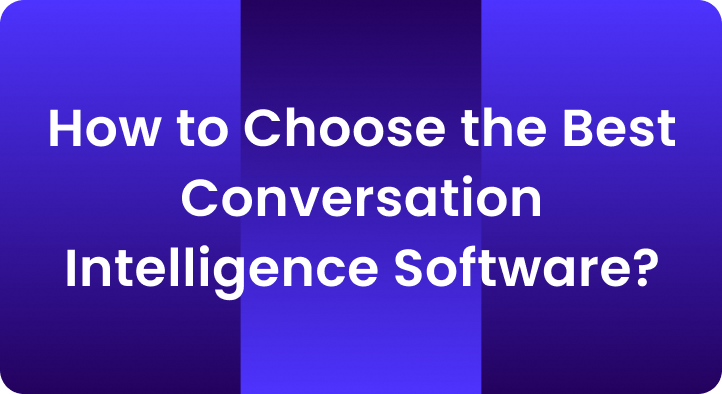69% of consumers are still loyal to certain brands in 2024
When your customers walk into their favorite store or visit their trusted service provider’s website, there is a special feeling that draws them back time and time again.
That feeling is customer loyalty.
It grows when businesses consistently deliver value that goes beyond transactions. As a result, customers keep coming back, sharing your story with friends, and becoming walking billboards for your brand.
In today’s article, we’ll examine customer loyalty, why it’s crucial, how to track and build it, and the pitfalls to avoid.
Let’s get started.
A. What is customer loyalty?
Customer loyalty is the ongoing relationship and emotional bond between you and your customers.
It forms when your buyers choose to engage with your brand over an extended period.
Loyal customers return for repeat purchases, happily share honest opinions, offer referrals, and look to you instead of competitors—even when cheaper or alternative options exist.
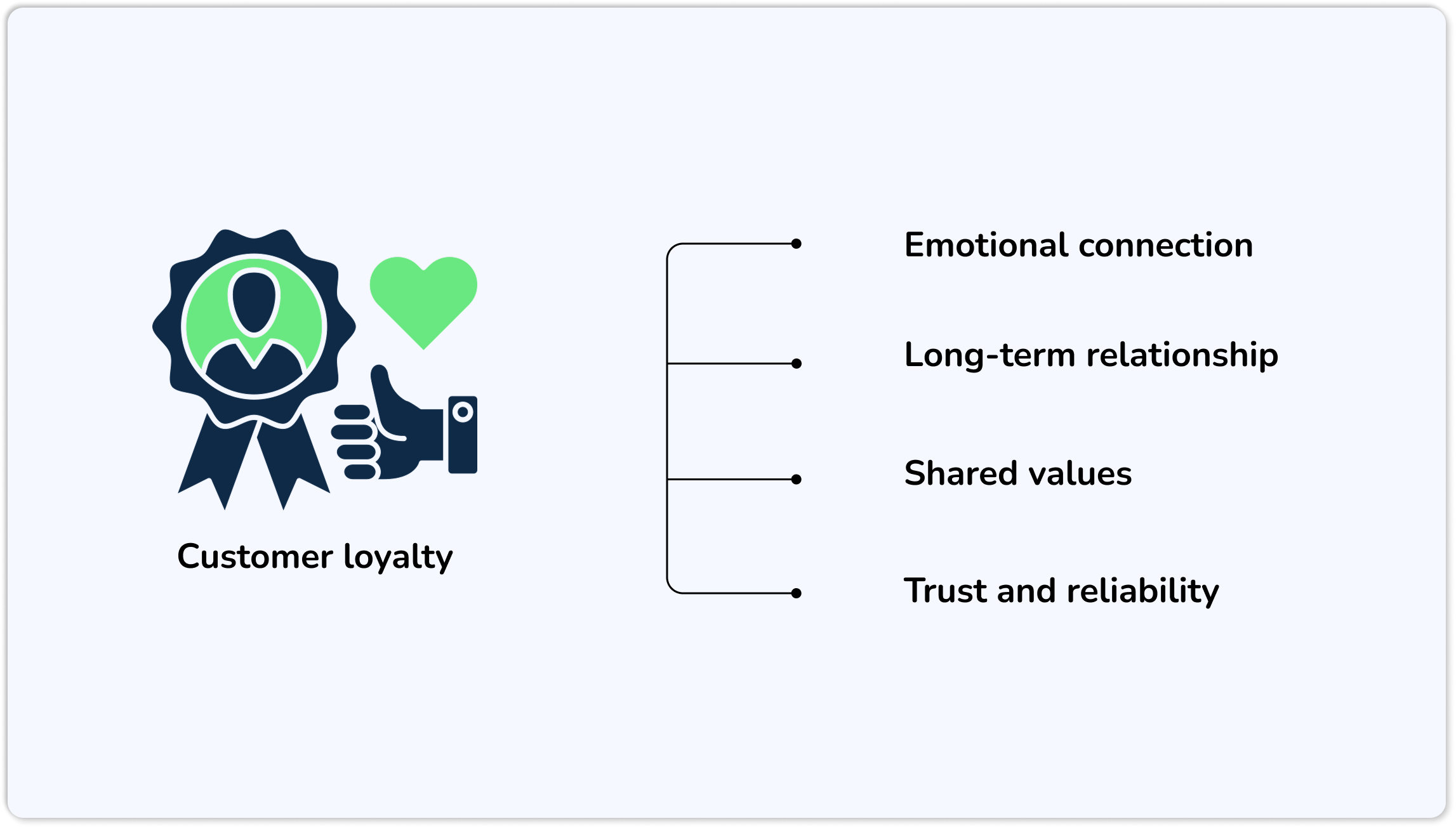
Key elements of customer loyalty
- Emotional connection: People often buy based on positive feelings and experiences.
- Long-term relationship: Customer loyalty isn’t a one-time gig; it’s about continuous engagement.
- Shared values: Customers want their favorite brands to reflect their own beliefs, whether those are about eco-friendly production, outstanding customer service, or unwavering integrity.
- Trust and reliability: A loyal customer trusts you to solve problems, deliver quality, and continually innovate.
B. Why is customer loyalty important?
Think of customer loyalty as a powerful force propelling long-term business success. Loyal buyers are not merely casual shoppers. They are vital ambassadors who can help sustain your growth.
Here’s why:
- Customer retention is cheaper than acquisition: Studies show that acquiring a new customer can cost up to five times more than retaining an existing one. Loyal customers enhance your margins because the cost of advertising to them decreases over time, while their repeat purchases go up.
- Brand loyalty boosts word-of-mouth: Loyal fans are likely to rave about your offerings. They often bring friends and family on board, creating a cycle of new, but warmer, leads.
- Higher revenue from repeat customers: On average, repeat customers spend 67% more than new ones. A dedicated buyer readily explores premium or additional products, which increases customer lifetime value.
- Stronger brand reputation: Positive reviews and testimonials elevate your brand, especially in industries where trust is pivotal. Satisfied customers typically grant you a second chance if you make a mistake, as they have already proven your commitment.
- Stronger resilience in market shifts: During economic downturns or heightened competition, your loyal customers stay put. They are less price-sensitive and more willing to remain loyal during challenging times.
C. How to measure customer loyalty?
Measuring customer loyalty isn’t one-size-fits-all. You’ll likely use several metrics to capture the bigger picture:
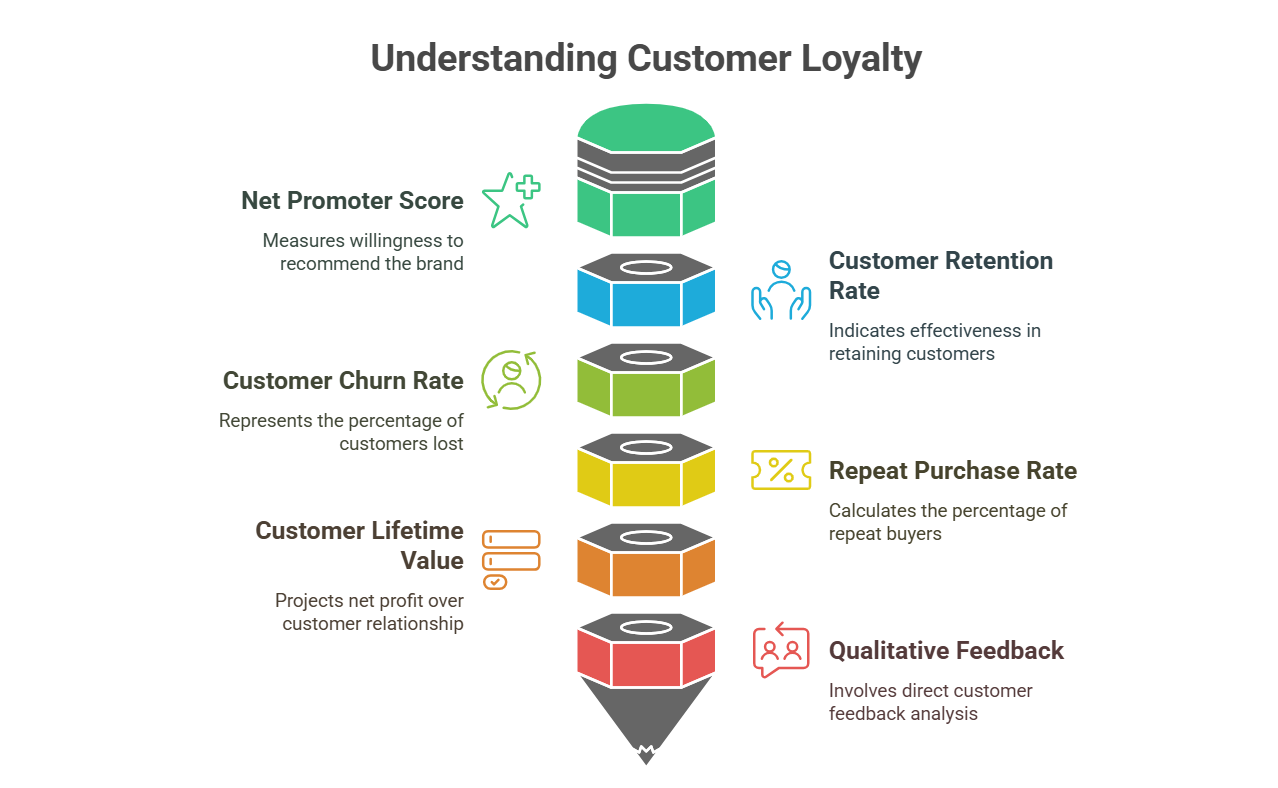
1. Net promoter score (NPS)
NPS=% of Promoters−% of Detractors
This measures willingness to recommend your brand. You ask customers: “How likely are you to recommend [brand] to a friend, on a scale of 0 to 10?”
- Detractors: 0-6
- Passives: 7-8
- Promoters: 9-10
Your NPS is the percentage of Promoters minus the percentage of Detractors. A high NPS generally signals strong brand loyalty.
2. Customer retention rate (CRR)
(customers at end of period)−(new customers acquired)/(customers at start of period)×100%
CRR indicates how effectively you keep existing buyers over a set timeframe. If your retention rate is consistently high, it’s a good sign that your customer loyalty strategies are working.
3. Customer churn rate (CCR)
This is the flip side of CRR: the percentage of customers lost over a given period.
Reducing customer churn is crucial for maintaining and growing a successful business. A high churn rate can highlight loyalty issues, prompting an immediate review of service quality, loyalty programs, and brand communication.
4. Repeat purchase rate (RPR)
This metric calculates the percentage of your customers who make more than one purchase within a specific period.
RPR is a helpful snapshot of how many buyers transition into repeat customers.
5. Customer lifetime value (CLV)
CLV measures the projected net profit generated over a buyer’s entire relationship with your brand.
A higher CLV signals a loyal base, as devoted customers often spend more and stay longer.
6. qualitative feedback
In addition to metrics, pay attention to direct feedback, such as social media comments, reviews, and surveys.
Tools like speech analytics or conversation transcripts can unearth hidden sentiments behind loyalty or dissatisfaction.
D. What is the difference between customer loyalty and customer satisfaction?
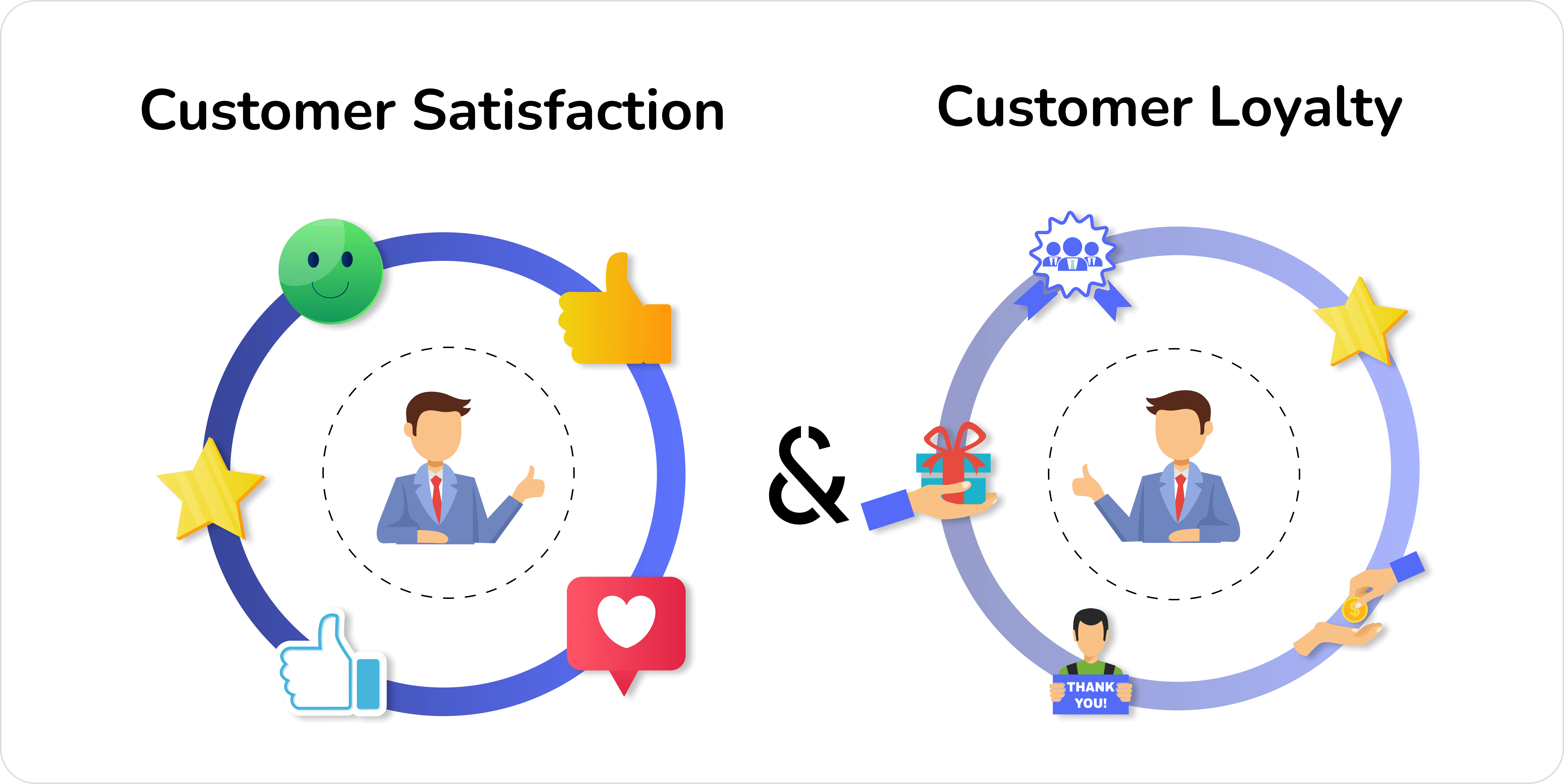
It’s easy to mix up customer loyalty and customer satisfaction, but they aren’t identical. Both are vital, but each focuses on different aspects.
Customer satisfaction
- Measures the short-term contentment a customer feels after a purchase or experience.
- A satisfied customer rates you well on immediate service or product delivery.
- However, satisfaction can be fleeting. Someone might be satisfied but still open to switching brands if they find a better deal.
Customer loyalty
- It encompasses a deeper, long-term preference for your brand, guided by trust, value alignment, and positive experiences over time.
- Loyal individuals aren’t simply content with one interaction; they repeatedly choose you, even if competitors offer promos or lower costs.
All loyal customers are generally satisfied. However, not all satisfied customers necessarily become loyal. Loyalty goes beyond a single transaction. It’s about ongoing engagement, emotional connections, and personal trust in a brand’s promise.
E. How to build the right customer loyalty?
Designing a consistent loyalty approach demands not only excellent products but also emotional resonance and consistent engagement.
Below are proven customer loyalty strategies:
1. Identify your most valued customers
Begin by taking a close look at your best-performing customer segments. Ask yourself:
- Who buys frequently?: Look for patterns among repeat buyers who consistently choose your products.
- Who leaves glowing reviews or champions your brand on social media?: Identify those who actively share their positive experiences.
- What does the data say?: Analyze customer behavior and feedback to determine which loyalty rewards resonate the most. Discover which channels—be it email, social media, or in-store experiences—drive their purchase decisions.
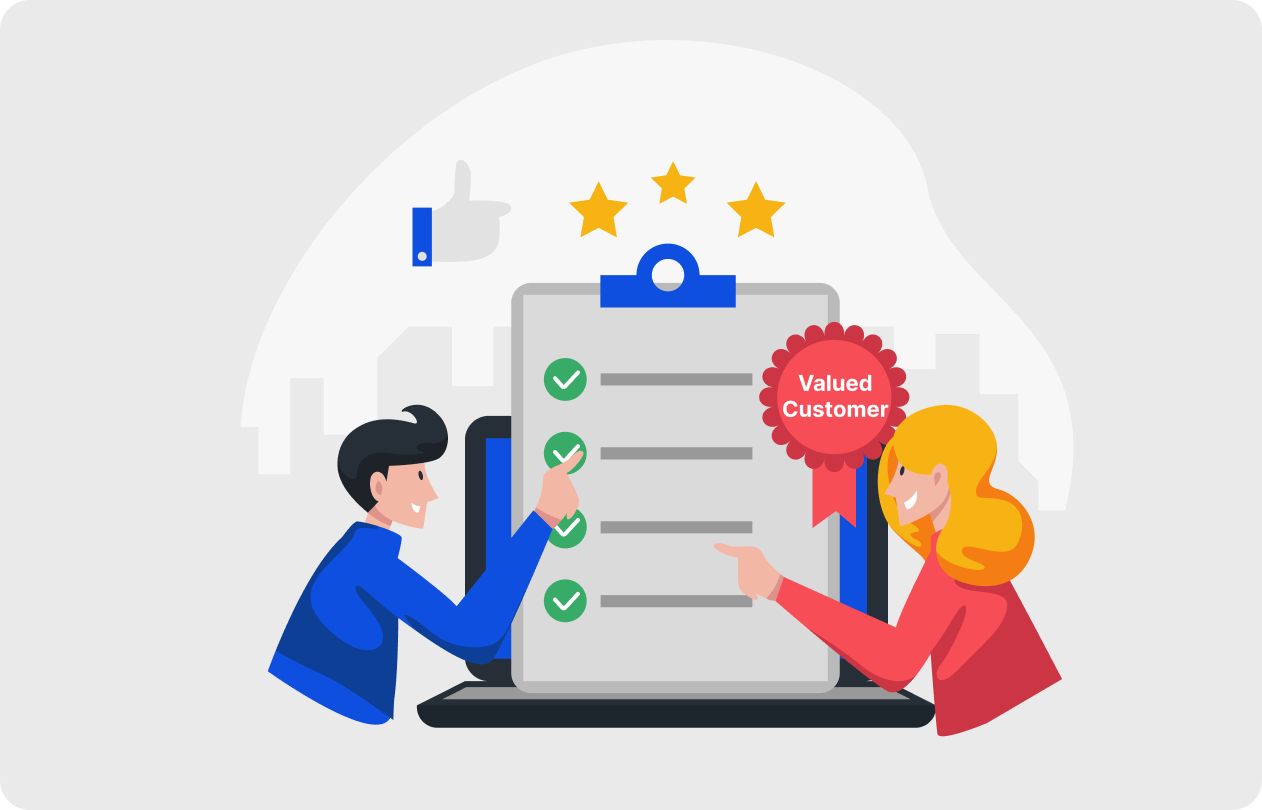
2. Personalize every interaction
Personalization is the cornerstone of trust. When you treat each customer as an individual, you strengthen your relationship and boost brand loyalty. Here’s how to personalize effectively:
- Use their name: Greet customers by name in emails and communications to create a warm, personal touch.
- Tailor recommendations: Leverage purchase history and browsing behavior to suggest products or services that truly match their needs.
- Customize offers: Send targeted promotions that reflect their interests and previous purchases.
3. Launch loyalty programs that work
A well-designed loyalty program can transform one-time buyers into lifelong supporters. Consider these types of programs:
- Points-based programs: These award points for every purchase, which customers can later redeem for freebies, upgrades, or discounts. This creates a tangible way for customers to see the benefits of staying with your brand.
- Tiered programs: Introduce different levels (e.g., silver, gold, platinum) where each tier unlocks progressively better perks. This encourages customers to strive for higher levels of engagement.
- Paid membership models: Offer a subscription-based loyalty program that provides exclusive premium services or benefits for a recurring fee.
Keep the program simple and easy to join. Customers who understand how to earn and redeem rewards are more likely to participate actively.
4. Give meaningful rewards
Avoid generic freebies and instead offer rewards that speak directly to your customers’ desires:
- Exclusive offers: Provide members with early access to new releases, special discounts, or limited-edition items.
- VIP services: Offer top-tier customers access to premium customer service, such as dedicated support lines or concierge services.
- Emotional perks: Send personalized thank-you messages, invite them to participate in co-creation sessions, or give them behind-the-scenes glimpses into your brand.
If you run a sports apparel brand, you could let your loyal customers test new products before release. This would make them feel special and deepen their connection to your brand.
5. Deliver a top-notch customer experience
A seamless and consistent customer experience is crucial to nurturing loyalty:
- Omnichannel engagement: Integrate your customer data across channels such as chat, social media, phone, and web forms. This ensures that the customer’s history and preferences inform every interaction.
- Speed and clarity: Resolve issues quickly, communicate clearly, and maintain respectful interactions. Fast, effective service can turn a one-time problem into a testament to your commitment.
- Consistent quality: Whether customers browse online or call support, every experience should reflect the same high standards.
6. Gather feedback and act on it
Regularly solicit feedback to understand what your customers truly need:
- Conduct surveys: Use CSAT (Customer Satisfaction) and NPS surveys to gauge satisfaction and measure loyalty indicators.
- Monitor reviews: Keep an eye on what customers are saying on public platforms and social media.
- Show responsiveness: If a customer suggests an improvement and you implement it, share the news widely. Demonstrating that you listen and adapt builds trust and reinforces customer loyalty.
Actively engaging with feedback ensures you stay in tune with customer expectations and continuously refine your approach.
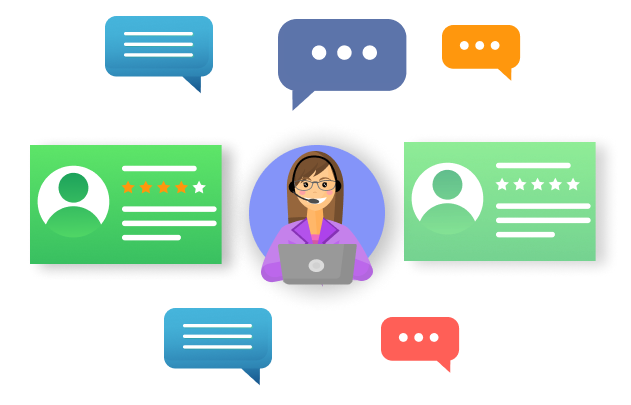
7. Align your brand with shared values
Customers remain loyal when they see their own beliefs reflected in your brand:
- Communicate your mission: Whether you support eco-friendly practices, social justice, or community involvement, communicate your values clearly in all communications.
- Be transparent: If you claim sustainability, openly explain your supply chain practices or philanthropic efforts.
- Build a community: Create opportunities for customers to connect over shared values, reinforcing their emotional bond with your brand.
8. Drive engagement with compelling content
Quality content can deepen your relationship with customers:
- Educational content: Share how-to guides, tutorials, or tips that help customers get more value from your products. For instance, a home improvement store could offer makeover tutorials on YouTube.
- Inspirational stories: Post customer success stories or behind-the-scenes looks at your brand to humanize your business.
- Entertaining material: Create engaging, fun content that resonates emotionally with your audience.
9. Encourage referrals and leverage social proof
Harness the power of word-of-mouth by turning loyal customers into advocates:
- Referral bonuses: Offer incentives to both the referring customer and the new lead. This will increase sales and reinforce the loyalty of your existing base.
- Reward top fans: Recognize and reward your most vocal supporters with shoutouts, exclusive gifts, or early access to special offers.
- Showcase reviews: Prominently display genuine testimonials and success stories on your website and social media channels. People trust real experiences shared by their peers more than polished advertisements.
F. Common pitfalls to avoid
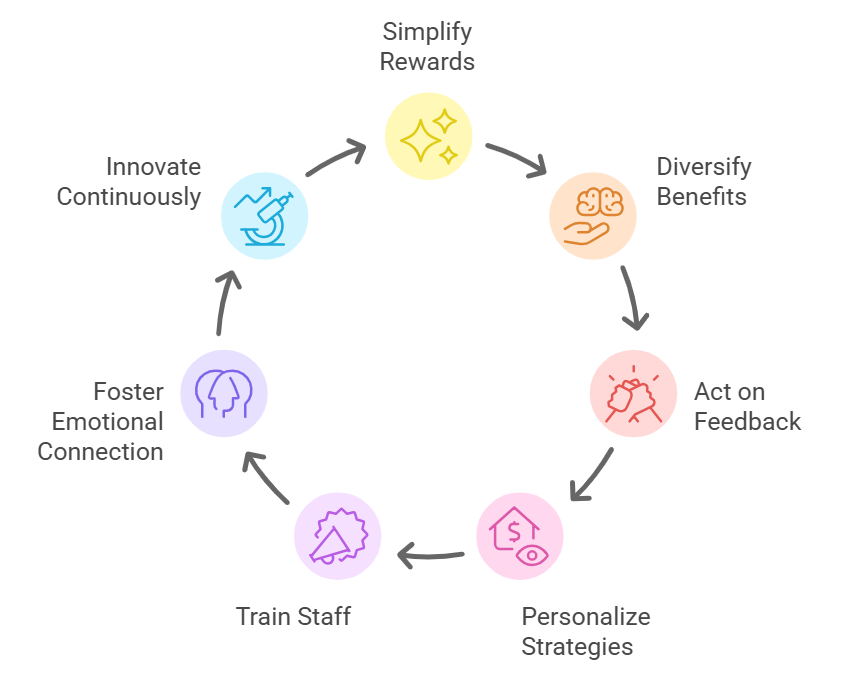
Even the best plans face obstacles. Avoid these pitfalls:
1. Overcomplicating loyalty programs: If customers can’t easily understand how to collect or redeem loyalty rewards, they’ll give up. Use clear language. Keep rules simple. Make point balances accessible on receipts, dashboards, or apps.
2. Focusing solely on discounts: Relying purely on coupons might erode perceived value or train people to wait for discounts. Balance monetary benefits with exclusive experiences or special access that can’t be priced.
3. Not listening to feedback: If you invite feedback but never act on it, you undermine trust. Even negative feedback is a gift—it highlights areas you can fix before they escalate.
4. One-size-fits-all strategy: Customers are unique. If your approach ignores their preferences or demographics, you risk irrelevance. Segment your audience, track data, and tailor your loyalty strategies to each group.
5. Underestimating internal training: Your staff must be brand ambassadors. They should understand every facet of your loyalty programs and brand values. This will be visible in the customer experience if they aren’t on board.
6. Neglecting emotional connection: Customer loyalty goes beyond “just the service.” Your loyalty efforts will struggle if your brand lacks an evident personality or mission. Show empathy, warmth, and gratitude at every turn to spark emotional ties.
7. Failing to evolve: Markets change, and customers’ needs shift. A static program can become stale. Continuously innovate, test new ideas, and adjust your loyalty offerings based on the latest insights.
E. Enthu.AI: strengthening customer loyalty through better engagement
Building strong customer loyalty depends heavily on the quality of your customer conversations. That’s where enthu.ai steps in.
We researched its capabilities thoroughly and are excited about its potential to transform customer engagement.
With enthu.ai, you can track the entire customer journey by reviewing interactions and transcriptions.
- One platform empowers every call, every agent, every day: With powerful speech analytics and advanced features, enthu.ai aids call centers, large businesses, and sales teams, enabling you to reduce churn, enhance revenue, and refine your customer experience.
- Call center monitoring and QA: Identify coaching opportunities, calibrate team performance, and refine conversations.
- Comprehensive dashboards and reports: Discover real-time performance insights, agent skill gaps, and training needs.
- Auto QA & AI-enabled: Automate quality checks for consistent agent evaluations, fueling continuous improvement.
- Personalized coaching: Provide targeted feedback to agents, so they’re equipped to deliver the best experiences.
Conclusion
Customer loyalty is a powerful cornerstone for any business that wants sustainable growth. By providing excellent customer engagement, authentic connections, and meaningful loyalty rewards, you’ll keep customers around longer—and ensure they bring their friends with them.
Keep your brand promise by actively listening to concerns, addressing issues quickly, and rewarding people who stand by you. Measure your loyalty metrics, refine your approach, and never forget the emotional ties that anchor loyalty.
Incorporating unwavering brand values into every customer interaction creates an environment in which customer loyalty grows naturally.
And remember: you don’t have to do it alone. Partnering with conversation analytics software like enthu.ai can help you coach teams faster, boost call center efficiency, and cultivate higher customer retention.
Embrace the power of next-level engagement, and watch your repeat customers become lifelong brand advocates.
FAQs
1. What is customer loyalty?
Customer loyalty refers to the customer’s steady in a brand, rooted in positive experiences, quality, and trust. This loyalty results in repeat purchases, referrals, and long-term loyalty engagement. Examples include subscription renewals, brand loyalty, and selecting a product or service even when faced with competitors’ offers.
2. How to build loyalty customers?
Focus on genuine relationships. Offer an easy-to-use loyalty program, personalize each interaction, and listen carefully to feedback. Show empathy and align your brand with shared values to strengthen emotional connections.
3. What are the 4 C’s of customer loyalty?
The four C’s are Connectivity, Consistency, Creativity, and Communication. Connectivity means making it simple for customers to engage with you; consistency means delivering the same positive experience each time; creativity keeps your offerings fresh and memorable; and effective communication ensures customers remain informed and valued.
4. What are the 4 stages of loyalty?
Typically, the stages are Awareness, Research/Consideration, Purchase, and Advocacy. During Awareness, customers learn about your brand; during Research, they explore details and read reviews; during Purchase, they become paying customers; during Advocacy, they recommend you to others and become repeat buyers.
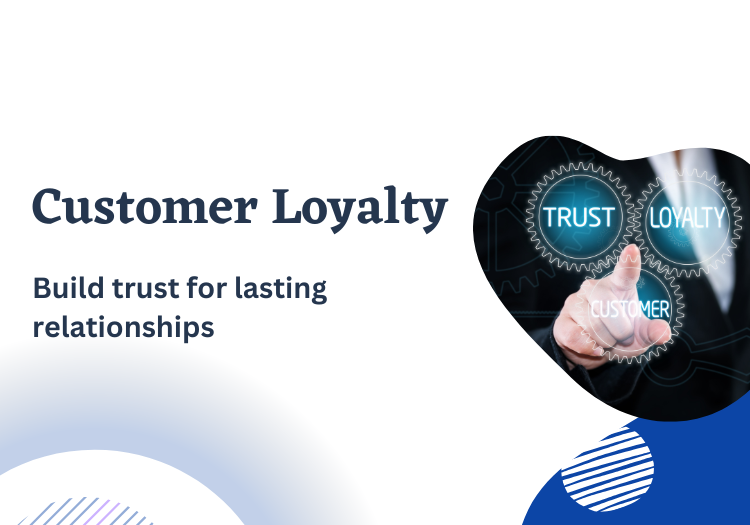


 On this page
On this page